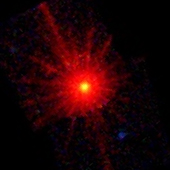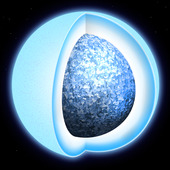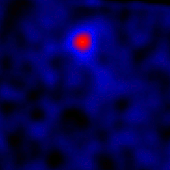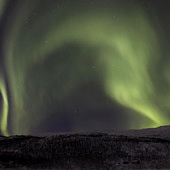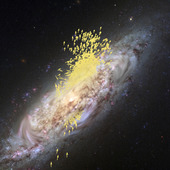ESA Science & Technology - Science Results
Science Results
Science Results
In a powerful example of combining multi-mission satellite data with computer simulations, scientists have used ESA's Cluster mission to reveal details about how electrons interact with waves in Earth's magnetic environment.
Published: 4 March 2019
Using unprecedented in-situ data from ESA's Cluster mission, scientists have shed light on the ever-changing nature of Earth's shield against cosmic radiation, its bow shock, revealing how this particle accelerator transfers and redistributes energy throughout space.
Published: 27 February 2019
ESA's Gaia satellite is on a mission: to map and characterise more than one billion of the stars in the Milky Way. Many of these stars reside in complex, eye-catching clusters scattered throughout our Galaxy and, by studying these stellar groupings, Gaia is revealing much about the formation and evolution of stars in our cosmic home and...
Published: 26 February 2019
Astronomers using the NASA/ESA Hubble Space Telescope, along with older data from the Voyager 2 probe, have revealed more about the origin of Neptune's smallest moon. The moon, which was discovered in 2013 and has now received the official name Hippocamp, is believed to be a fragment of its larger neighbour Proteus.
Published: 20 February 2019
The outermost part of our planet's atmosphere extends well beyond the lunar orbit – almost twice the distance to the Moon.
Published: 20 February 2019
ESA's Gaia satellite has looked beyond our Galaxy and explored two nearby galaxies to reveal the stellar motions within them and how they will one day interact and collide with the Milky Way – with surprising results.
Published: 7 February 2019
Astronomers using the NASA/ESA Hubble Space Telescope to study some of the oldest and faintest stars in the globular cluster NGC 6752 have made an unexpected finding. They discovered a dwarf galaxy in our cosmic backyard, only 30 million light-years away.
Published: 31 January 2019
Investigating the history of our cosmos with a large sample of distant 'active' galaxies observed by ESA's XMM-Newton, a team of astronomers found there might be more to the early expansion of the Universe than predicted by the standard model of cosmology.
Published: 28 January 2019
ESA's high-energy space telescopes INTEGRAL and XMM-Newton have helped to find a source of powerful X-rays at the centre of an unprecedentedly bright and rapidly evolving stellar explosion that suddenly appeared in the sky earlier this year.
Published: 10 January 2019
The NASA/ESA Hubble Space Telescope has discovered the brightest quasar ever seen in the early Universe. After 20 years of searching, astronomers have identified the ancient quasar with the help of strong gravitational lensing.
Published: 9 January 2019
Astronomers using ESA's XMM-Newton space observatory have studied a black hole devouring a star and discovered an exceptionally bright and stable signal that allowed them to determine the black hole's spin rate.
Published: 9 January 2019
Data captured by ESA's galaxy-mapping spacecraft Gaia has revealed for the first time how white dwarfs, the dead remnants of stars like our Sun, turn into solid spheres as the hot gas inside them cools down.
Published: 9 January 2019
A new study reveals that, contrary to first impressions, Rosetta did detect signs of an infant bow shock at the comet it explored for two years – the first ever seen forming anywhere in the Solar System.
Published: 12 December 2018
Based on a new theoretical model, a team of scientists explored the rich data archive of ESA's XMM-Newton and NASA's Chandra space observatories to find pulsating X-ray emission from three sources.
Published: 21 November 2018
Space weather is no abstract concept – it may happen in space, but its effects on Earth can be significant. To help better forecast these effects, ESA's Cluster mission, a quartet of spacecraft that was launched in 2000, is currently working to understand how our planet is connected to its magnetic environment, and unravelling the complex...
Published: 8 November 2018
ESA's Gaia mission has made a major breakthrough in unravelling the formation history of the Milky Way. Instead of forming alone, our Galaxy merged with another large galaxy early in its life, around 10 billion years ago.
Published: 31 October 2018
Since 13 September, ESA's Mars Express has been observing the evolution of an elongated cloud formation hovering in the vicinity of the 20 km-high Arsia Mons volcano, close to the planet's equator.
Published: 25 October 2018
Scanning the sky for X-ray sources, ESA's XMM-Newton X-ray observatory has been busy with the XXL Survey, its largest observational programme to date. The second batch of data from the survey has just been released, including information on 365 galaxy clusters, which trace the large-scale structure of the Universe and its evolution through time,...
Published: 4 October 2018
Using the NASA/ESA Hubble Space Telescope and older data from the Kepler Space Telescope two astronomers have found the first compelling evidence for a moon outside our own Solar System. The data indicate an exomoon the size of Neptune, in a stellar system 8000 light-years from Earth. The new results are presented in the journal Science Advances.
Published: 3 October 2018
A team of astronomers using the latest set of data from ESA's Gaia mission to look for high-velocity stars being kicked out of the Milky Way were surprised to find stars instead sprinting inwards – perhaps from another galaxy.
Published: 2 October 2018
—
20 Items per Page











